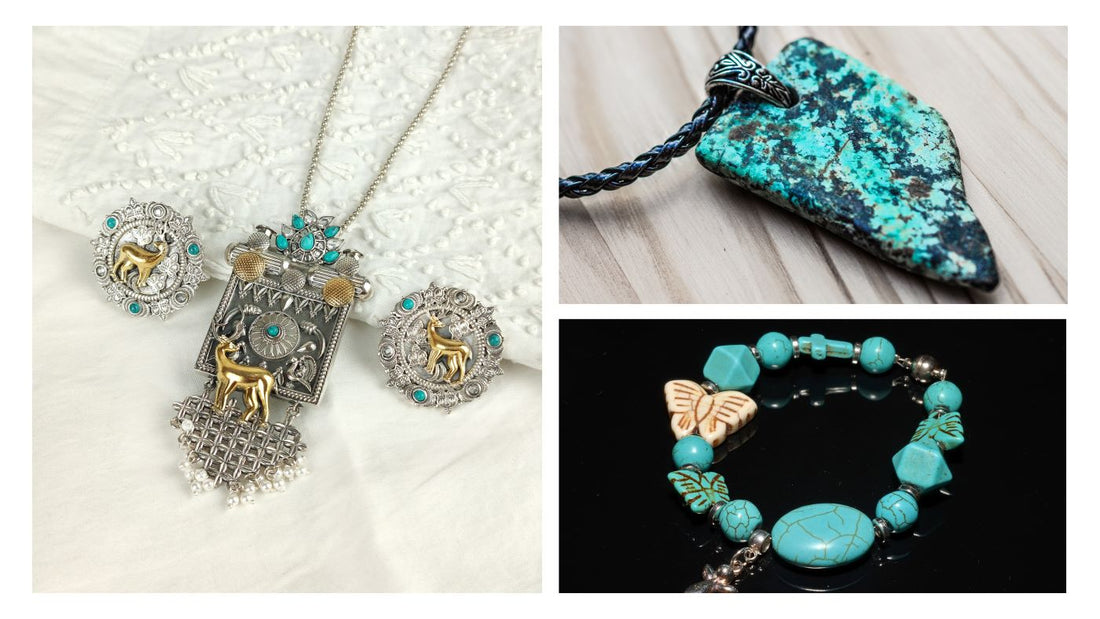
Turquoise: Captivating Cultures Across Time
Share
Turquoise, with its captivating blue-green hues, has been a treasured gemstone for thousands of years. Its appeal transcends time and cultures, from ancient civilizations to modern-day societies. The rich cultural significance and history of turquoise reveal the reasons behind its enduring popularity, showcasing how this mesmerizing gemstone has captured the hearts and imaginations of people across the globe.
Ancient Origins
Turquoise is perhaps one of the oldest gemstones in human history, cherished by various cultures across the globe. Ancient Egyptians, Persians, Chinese, Aztecs, Incas, and Native North Americans all considered turquoise sacred and used it for adornment, power, luck, and protection. Turquoise beads dating back to 5000 B.C. have been found in Iraq, and the Egyptians were mining turquoise in the Sinai as early as 3200 B.C. The death mask of Tutankhamun was studded with turquoise, and it adorned mosaic masks, shields, and power statues of Aztec rulers.
Ancient Egyptian Culture
In ancient Egypt, turquoise was highly prized and often used in jewelry and decorative objects. The Egyptians considered turquoise a sacred stone, associating it with the goddess Hathor, who was revered as a protective deity that brought good luck and blessings. Turquoise was also used in burial rituals, as it was thought to protect the deceased in the afterlife. The iconic burial mask of Tutankhamun features striking turquoise inlays, showcasing the gem's importance in Egyptian culture.

Persian (Iranian) Culture
Turquoise has been highly valued in Persian culture for centuries, often referred to as "firuza," meaning "victorious" or "the stone of victory." The Persians believed that wearing turquoise could ward off evil, bring good fortune, and offer protection against the evil eye (negative energy directed toward an individual). Persian turquoise, particularly from the Nishapur region, is renowned for its exceptional quality and vibrant blue color. The use of turquoise in Persian architecture, such as in domes and mosaics, further demonstrates its cultural significance.

Native American Traditions
For centuries, Native American tribes in the southwestern United States and Mexico have held turquoise in high regard. The Apache, Navajo, Zuni, and other tribes consider turquoise a sacred stone imbued with spiritual significance. In these cultures, turquoise is believed to promote healing, provide protection, and bring good fortune to the wearer. Native Americans have mined and fashioned turquoise for nearly a thousand years, using it to guard their burial sites. Indian priests wore it during ceremonies when calling upon the great spirit of the sky.
Native American artisans have skillfully incorporated turquoise into intricate jewelry designs, often combining it with silver and other materials. These pieces not only serve as adornments but also carry deep cultural meaning and are passed down through generations as cherished heirlooms. The popularity of Native American turquoise jewelry in the late 19th century led to a surge in demand for the gemstone and the opening of numerous turquoise mines in Arizona, Nevada, New Mexico, and Colorado.

Aztec Culture
In Aztec culture, turquoise was considered a precious stone and was often used in jewelry and decorative objects. The Aztecs associated turquoise with the god Quetzalcoatl, who was believed to be the creator of the world and the god of wind, air, and learning. Turquoise was also used in Aztec mosaics and was believed to have spiritual and protective properties. The Aztecs valued turquoise for its beauty and its connection to the divine.

Chinese Culture
In Chinese culture, turquoise has been valued for its beauty and symbolic significance. The Chinese associate turquoise with the concept of protection and believe that it can bring good luck and fortune. Turquoise has been used in Chinese art, sculpture, and jewelry for centuries, often carved into intricate designs and paired with other auspicious symbols.
The use of turquoise in Chinese culture extends beyond personal adornment. It has been incorporated into decorative objects, such as vases and figurines, and even used in architectural elements like roof tiles and ornamental gates. In ancient Chinese burials, such as the Erlitou site dating back to 1900-1500 BCE, archaeologists have discovered turquoise artifacts, including a remarkable turquoise-inlaid dragon-shaped object, showcasing the gem's cultural importance.

Ornamental bronze plaques inlaid with turquoise pieces from Erlitou site.
Symbolism and Spiritual Significance
Turquoise is often associated with wisdom, nobility, and the power of immortality. It bridges heaven and earth, making it a sacred stone in many cultures. Turquoise is a stone for finding wholeness, truth, and authenticity. It stimulates and harmonizes the Throat Chakra, making it easier to articulate and express wisdom. Some believe that turquoise grows pale when its owner is sick or sad, loses color upon death, and gradually recovers its color when transferred to a new healthy owner.

Protective and Healing Properties
For centuries, turquoise has been recognized as a protective stone. Turkish soldiers used it as amulets to guard against falls. It is believed to aid in respiratory and immune system health, alleviate cramps, and promote detoxification.
The Enduring Legacy of Turquoise in World Cultures
From ancient Egyptian tombs to Persian palaces, and from Aztec mosaics to Native American jewelry, turquoise has left an indelible mark on the cultural landscape. Its timeless allure stems from its beauty and the profound symbolic meanings attached to it by diverse civilizations throughout history.
As we continue to appreciate and adorn ourselves with turquoise in the modern era, we pay homage to the rich cultural heritage and significance of this captivating gemstone. Turquoise's influence can still be seen in contemporary fashion and design, a testament to its enduring appeal. For more information on how turquoise is making waves in the modern fashion world, be sure to check out our article on contemporary turquoise styles.
Whether you are drawn to its vibrant hues, its spiritual connotations, or its connection to ancient traditions, turquoise remains a timeless treasure that will continue to enchant and inspire for generations to come.
